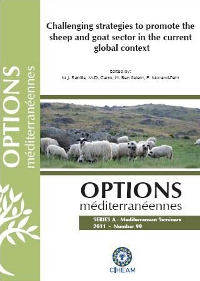| Article précédent | p. 169-174 | Article suivant |
Diversity of bacterial communities isolated from the solid and liquid phase of the rumen of sheep fed diets of variable composition
The aim of this study was to analyze bacterial diversity in bacterial pellets isolated from the solid (SAB) and liquid (LAB) phase of the rumen in sheep fed different diets. Four rumen-fistulated sheep were fed 4 diets with forage:concentrate ratios (F:C) of 70:30 (HF) or 30:70 (HC) and either alfalfa hay or grass hay as forage (FOR). SAB and LAB were isolated from each sheep immediately before feeding, and the automated ribosomal intergenic spacer analysis (ARISA) of the 16S ribosomal DNA was used to analyze bacterial diversity. A total of 168 peaks were detected in the ARISA electropherograms across the total 32 bacterial pellets, with 6 peaks only found in SAB and 8 found only in LAB. The SAB isolated from sheep fed HF diets had greater number of peaks and Shannon index than those from sheep fed HC diets (P=0.03 and 0.05, respectively), and SAB from sheep fed grass hay diets had greater values of both parameters than those isolated from sheep receiving alfalfa hay diets (P=0.002 and 0.004). In contrast, LAB profile was not affected (P=0.23 to 0.65) by either F:C ratio or FOR. The results indicate that SAB are more markedly affected by dietary characteristics than LAB.
L'objectif de ce travail était d'analyser la diversité bactérienne des pellets isolés à partir de la phase solide (SAB) et la phase liquide (LAB) du rumen chez les moutons alimentés avec deux régimes différents. Quatre moutons munis de canules ruminales ont été utilisés selon un schéma en carré latin incomplet. Les quatre régimes expérimentaux avaient des rapports fourrage:concentré 70 : 30 (HF) ou 30 : 70 (HC), le fourrage étant soit du foin de luzerne soit du foin d'herbe. SAB et LAB ont été isolés dans chaque mouton juste avant la prise d'aliments, et la diversité bactérienne a été caractérisée par ARISA (automated ribosomal intergenic spacer analysis). Un total de 168 pics a été détecté dans les électrophérogrammes d'ARISA des 32 pellets bactériens, avec seulement 6 pics trouvés dans les SAB et seulement 8 trouvés dans les LAB. Les pellets SAB isolés chez les moutons recevant les régimes HF ont eu un plus grand nombre de pics et un index de Shannon plus élevé que ceux des régimes HC (P=0,03 et 0,05, respectivement), et les pellets SAB isolés chez les moutons recevant du foin d'herbe ont eu des valeurs plus élevées pour les deux paramètres que ceux isolés chez des moutons recevant du foin de luzerne (P=0,002 et 0,004). En revanche, le profil des pellets LAB n'a pas été affecté (P=0,23 à 0,65) par les rapports fourrage:concentré.ou par le type de fourrage. Les résultats indiquent que les pellets SAB sont plus nettement affectés par les caractéristiques du régime alimentaire que les pellets LAB.
- [ Afficher ]
- [ Télécharger ]
- [ Exporter la citation ]
Vous pouvez télécharger la citation au format :
- [ Imprimer ]
-
Mots-clés
FOURRAGE, OVIN, BACTERIE DU RUMENCiter cet article
Saro C., Carro M.D., Tejido M.L., Ranilla M.J. Diversity of bacterial communities isolated from the solid and liquid phase of the rumen of sheep fed diets of variable composition. In : Ranilla M.J. (ed.), Carro M.D. (ed.), Ben Salem H. (ed.), Morand-Fehr P. (ed.). Challenging strategies to promote the sheep and goat sector in the current global context. Zaragoza : CIHEAM / CSIC / Universidad de León / FAO, 2011. p. 169-174. (Options Méditerranéennes : Série A. Séminaires Méditerranéens; n. 99). 13. International Seminar of the Sub-Network on Nutrition of the FAO-CIHEAM Inter-Regional Cooperative Research and Development Network on Sheep and Goats, 2009/10/14-16, León (Spain). http://om.ciheam.org/om/pdf/a99/00801552.pdf



